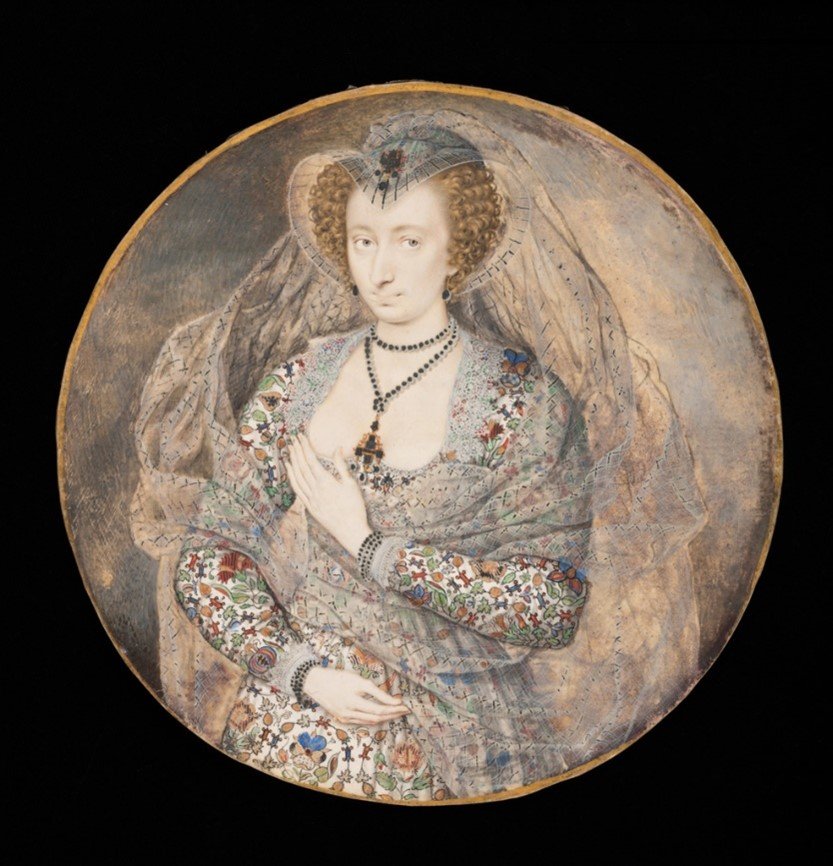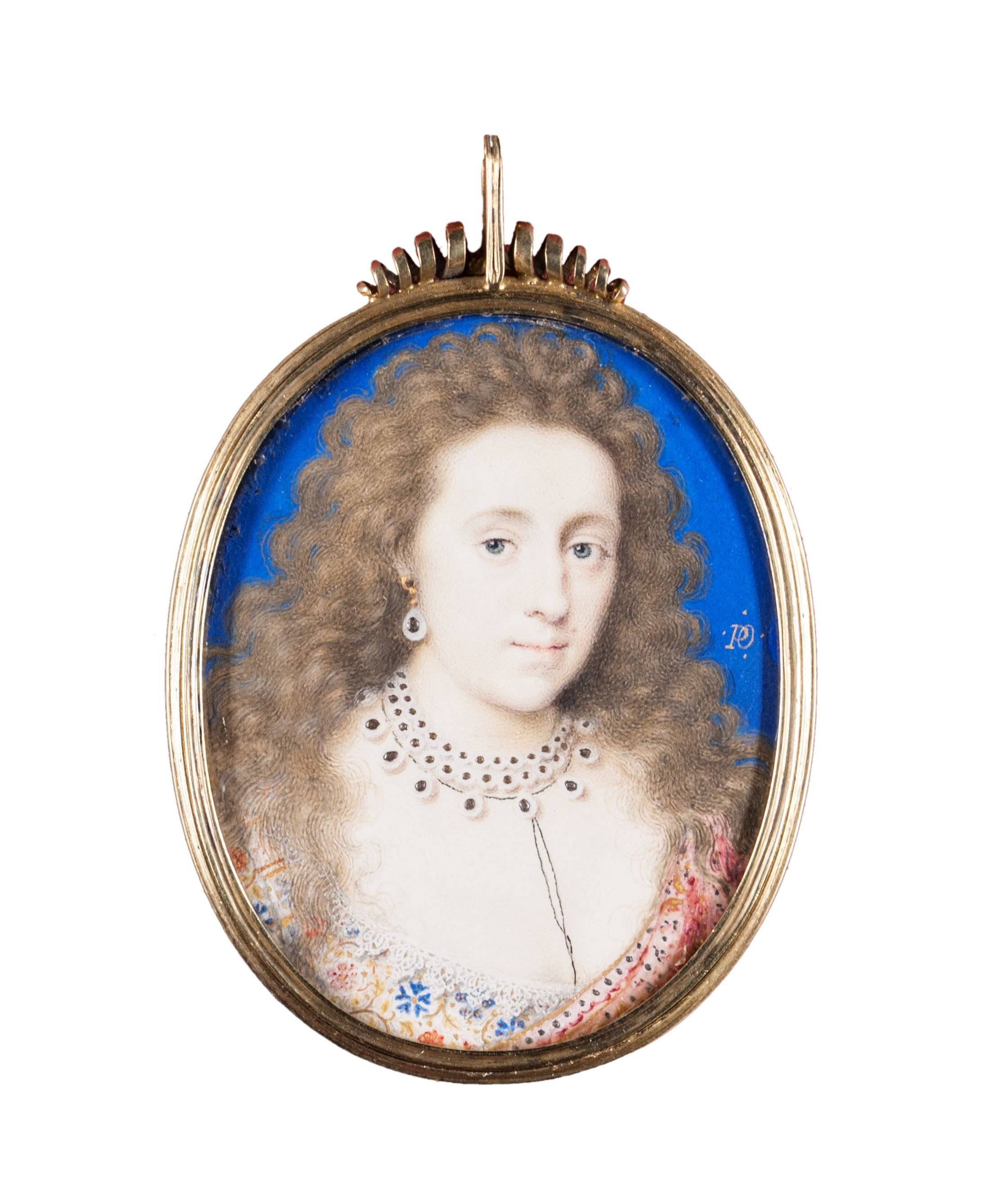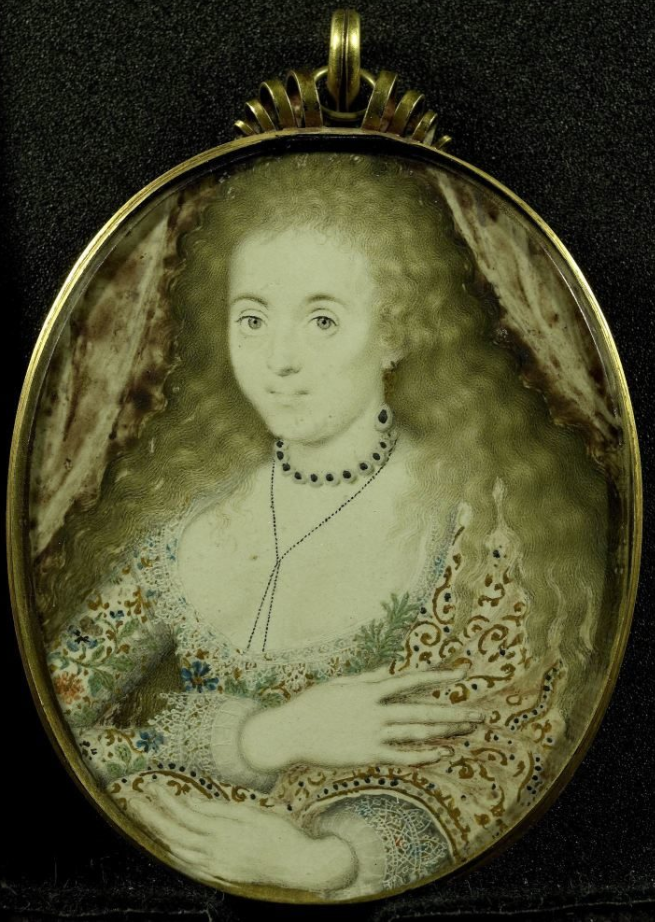Capturing the Court Masque in Miniature
By Sophie Rhodes | 12 December 2023
The most extravagant and exclusive form of courtly entertainment during the first half of the seventeenth century was undoubtedly the masque. Huge sums of money were spent on these performances, which centred around illusionistic set designs, elaborate costumes, music, dance, and light effects. Accounts document how courtiers and royalty performed these festivities late into the night. Usually commissioned by the monarch, masques explored allegorical and fantastical themes, lauding the triumph of virtue over vice, but always with the essential aim of glorifying the monarch. The pair responsible for many of these performances at the Stuart court was architect and designer Inigo Jones (1573-1652) and one of the most important early-modern playwrights, Ben Jonson (c.1572-c.1637).
Fig. 1 Unknown Woman in Masque Costume, perhaps as ‘Flora’, c. 1605, Isaac Oliver (c. 1565-1617) - Rijksmuseum, Amsterdam
Miniatures from the period reveal that participants commissioned portraits of themselves in masque attire as a way of memorialising the part they played in such performances. Like the masque, the miniature had a selective audience which allowed the visual depiction of the human body to be at times more revealing than would have been possible elsewhere. Another similarity between the two art forms was the attention paid to elaborate costumes and illusionistic effects. Isaac Oliver’s miniatures of masque performers were the earliest of their type to document masque attire in miniature format. Following on from him, miniaturists of the first half of the seventeenth century created portraits which did not link to specific masques, but instead evoked the event’s style and atmosphere, demonstrating that the masque aesthetic became deeply connected to self-fashioning in miniature format.
The earliest miniatures made by Isaac Oliver which depict sitters in masque costume date to the first decade of the seventeenth century. They mainly show women, often in revealing costumes, wearing unusual jewellery and headpieces. One example is a miniature of an unknown woman, traditionally thought to be Frances Howard, Countess of Somerset (1590-1632). She appears in a silvery costume with a delicately painted transparent veil. It has been suggested that the miniature shows a performer from Hymenaei (1606).[1] In this, the female masquers were described as wearing ‘white cloth of silver’ and, with an overall colour theme of white, gold and silver, there is certainly a close resemblance to this sitter’s ensemble.[2] Two further miniatures by Isaac Oliver show unknown sitters in masque costume. One is of a woman likely in the guise of ‘Flora’, the Roman goddess of spring [Fig. 1]. Her hair is adorned with a headpiece of flowers and jewellery, and she wears an antique-style outfit with transparent fabric covering her breasts. Her outfit is a clear indicator that she was a masque performer: several surviving masque costume designs by Inigo Jones show similarly revealing outfits.[3] A miniature, likely from 1609, shows another unknown woman with antique-style costume, including a grotesque ornament and mantle, a translucent veil and decorative jewelled headpiece (Victoria and Albert Museum). This miniature could relate to either of Jonson’s 1609 masques, The Masque of Beauty or The Masque of Queens.
Fig. 2 Anne of Denmark (1574-1619), c. 1610, Isaac Oliver (c. 1565-1617) © Royal Collection Trust.
By around 1610, the fashion for depicting sitters in masque costume had reached the royal family. Several miniatures survive of Henry Frederick, Prince of Wales, in which he wears masque costume, sitting in profile and depicted as a Roman emperor. He wears a gold-embellished red cloak and is set against an architectural niche. Likely at the same date, Prince Henry’s mother Anne of Denmark was painted by Isaac Oliver in a similar fashion [Fig. 2]: she is seen in profile, wearing a jewelled headpiece, translucent veil and is adorned with gold, silver, and pearl jewellery.
Fig. 3 Probably Lucy Harington, Countess of Bedford (1581-1627), c. 1615, Isaac Oliver (c. 1565-1617) - Fitzwilliam Museum
A prolific patron of the arts and an important sitter for Isaac Oliver was Lucy Harington, Countess of Bedford (1581-1627). At least five of her portraits by Oliver survive which likely relate to masques. One shows her wearing an embroidered low-cut costume, covered with fruits and flowers, and a translucent patterned veil that wraps around her body [Fig. 3]. Her representation in this way appears to have been an important starting point for a fashion in miniatures that took off in the second decade of the seventeenth century, in which women portrayed themselves in what could be termed ‘masque-inspired’ costumes. Over 20 miniatures survive by Isaac Oliver, Peter Oliver, and John Hoskins all of which show women in similar outfits [see Fig. 4. Victoria and Albert Museum P.3&A-1950, and Fig. 5]. Akin to Oliver’s miniatures of Lucy Harington, the sitters wear heavily embroidered costumes featuring stylised flowers. All have low necklines, often with a black thread necklace or string of pearls. Their hair is for the most part loose and in many a red antique-style mantle is draped across one shoulder.
Fig. 5 An Unknown Woman, c. 1615-20, Peter Oliver (c. 1589-1647) - Nationalmuseum Stockholm.
Called Arabella Stuart, c. 1615, Isaac Oliver (c. 1565-1617) - Rijksmuseum
The embroidered jacket seen in these miniatures is not quite a masque costume and these outfits do not match up with the masque costume designs by Inigo Jones. It has been speculated that the costume seen in these miniatures is an adaptation of outfits already owned by female sitters for a masque at home. There are several portraits which show sitters wearing the same patterned embroidered jacket, but with a high neckline, signifying informal, domestic attire [Fig. 6 Victoria and Albert Museum E.214-1994]. A surviving jacket of the period at the V&A with a low neckline shows signs of alterations, indicating that outfits seen in the miniatures could have been adaptations for a theatrical performance [Fig. 7 Victoria and Albert Museum 1359-1900]. However, it is surprising that so many miniatures exist depicting sitters in this outfit, suggesting that it was more likely a fashion to evoke the masque aesthetic, rather than alterations made to existing garments.
In fact, the use of embroidery in masques seems not to have been generally advised. In his essay Of Masques and Triumphs, Francis Bacon wrote for costumes that ‘rich embroidery’ is all but pointless, as ‘it is lost and not discerned.’[4] Yet the gold additions, classical-style mantle, jewellery, low neckline, and loose hair all evoke the fashion of masque attire. Female masquers in a performance held for Queen Elizabeth in 1600 were described as wearing ‘a mantel of carnacion taffeta cast under the arme, and their haire loose about their shoulders.’[5] The overall impact of these miniatures is a clearly intended allusion to the high-status, elite aesthetic of the masque, with the implication that sitters and collectors of such items wished to parade their close links with court etiquette.
The vogue for masque fashion in miniatures reached its apex in the years leading up to 1620, however the connection between the masque and small format paintings did continue. In 1632, Queen Henrietta Maria performed in the masque Tempe Restored, and subsequently commissioned the miniaturist John Hoskins to paint her portrait in masque costume [Fig. 7]. The costume Hoskins depicts her in does not exactly match the surviving costume designed for her by Inigo Jones, but the silver star patterned outfit is certainly consistent with it.[6] Her role in the masque was that of ‘Divine Beauty’ and the text details how ‘the Queen’s majesty was in a garment of watchet satin with stars of silver embroidered and embossed from the ground, and her head a crown of stars mixed with small falls of white feathers.[7]
Fig. 7 Queen Henrietta Maria (1609-1690), c. 1632, John Hoskins © Royal Collection Trust
More than any other type of portraiture, the atmosphere of the masque, with its flickering lights, movement, sparkling jewels, and colourful ensembles, could be captured in portrait miniature. Nicholas Hilliard pioneered the use of actual ground gold to depict jewels in his miniatures, thus making them glisten and glimmer when the miniatures caught the light. Revealing costumes also adapted well to the miniature format, where the recipient could control who viewed the object. To be represented in masque attire conveyed an exclusive status connected to the innermost court circles, and while the particular fashion for this type of masque dress in miniature was exclusive to the courts of James VI and I and Charles I, the miniature format retained its ability to convey discreet yet distinct messages.
[1] Jill Finsten, Isaac Oliver: Art at the Courts of Elizabeth I and James I, 2 vols (New York: Garland, 1981), ii, p. 77.
[2] Lesley Mickel, ‘Glorious Spangs and Rich Embroidery: Costume in The Masque of Blackness and Hymenaei’, Studies in the Literary Imagination, 36.2 (2003).
[3] For example, his outfit for A Lady Masquer, c.1600-05 (Chatsworth).
[4] Francis Bacon, Of Masques and Triumphs, 1597.
[5] This description is found in a letter from Rowland Whyte to Sir Robert Sidney in 1600, quoted in J. Nichols, The Progresses and Public: Processions of Queen Elizabeth I (London, 1823), iii, p. 498.
[6] S. Orgel and R. Strong, Inigo Jones: The Theatre of the Stuart Court (London, 1973), ii, pp. 501-503. 3
[7] Orgel and Strong, ii, p. 481.






